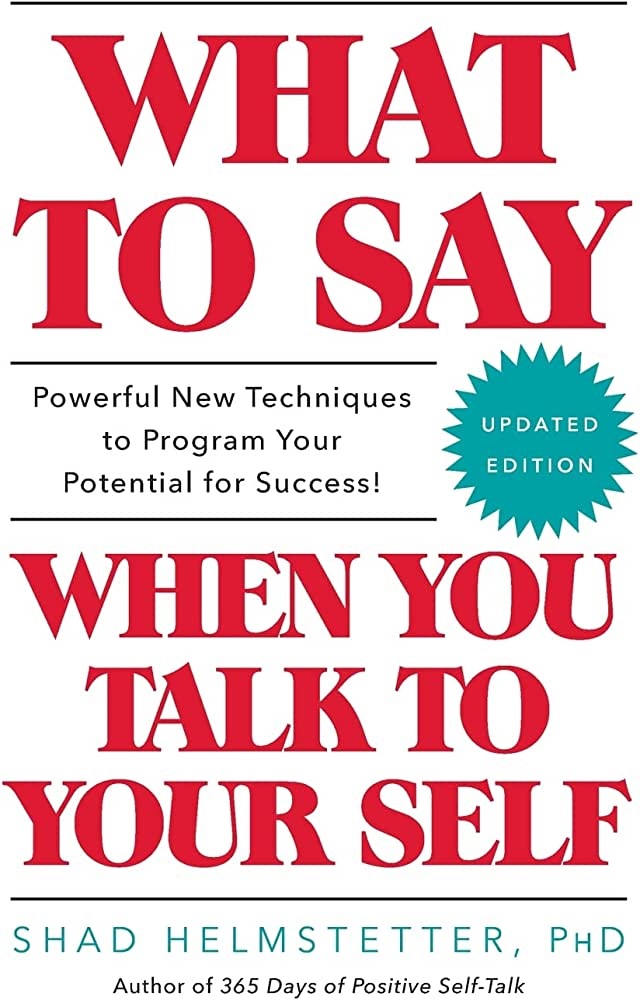Book – What to Say When You Talk to Yourself
Author – Shad Helmstetter Ph.D.
Genre – Self-help
Book Published in – 1986
Self-Talk is a practical way to live our lives by active intent rather than by passive acceptance.
we often believe that we are the product of our environment, the belief system handed to us by others, our observations, and what we soak from our experiences.
The Author claims that as much as what others say directly/indirectly shapes our lives, our self-talk can and does matter even more.
Surprisingly, as much as 77% of what we tell ourselves may work against us.
About the Book –
What to Say, When You Talk to Yourself claims that our self-talk plays a significant role in shaping our lives.
Fortunately, we can direct our Self-talk to build the life of our dreams rather than get adversely affected by it.
External solutions are temporary. The Self-Talk program leads to permanent behavioral change because you control all the messages, spoken or written, your brain receives.
In his quest for how any average human can fulfill all his dreams, the Author studied human behavior, motivational marketing, psychology, and the inner workings of self.
He found many answers but found only one solution. It’s Self-Talk.
Here are the Insights I gathered from the Book.
Lack of Self-Help Effectiveness –

- There are a lot of good self-help ideas and techniques. They should work, and they could, but they don’t because of something we all overlooked: That’s not how the brain works.
- Understanding this essential requirement of our mental machinery can help us make a simple but vital change in how we accept programming from others and, more importantly, what we say when we talk to ourselves.
Self-Talk –
- We all talk to ourselves all of the time. Our self-talk may be in spoken words or unspoken thoughts. It can be feelings, impressions, or even wordless physical responses.
- All of our thoughts, all of the pictures in our minds, are always tied to something else that we already know about.
- The more you think about anything in a certain way, the more you will believe that that is how it is.
- The mind works that way because the brain tries to tie any new thing you think to something you already believe.
A Wall of Negative Self-Talk –
- If everything you say to yourself becomes a directive to your subconscious mind, then any time you make a negative statement about yourself, you are directing your subconscious mind to make you become the person you just described negatively.
Programming the Mind –

Our programming sets up our beliefs, and the chain reaction begins logically.
- Programming creates Beliefs.
- Beliefs create Attitudes.
- Attitude creates Feelings.
- Feelings determine Actions.
- Actions create Results.
The Five Levels of Self-Talk –
Self-talk is a way to override our past negative programming by erasing or replacing it with conscious, positive new directions.
Self-Talk is a practical way to live our lives by active intent rather than by passive acceptance.
The Author claims there are five levels of Self-talks.
Level I – The level of negative self-acceptance – (I can’t) –
- “I can’t,” or “If only I could . . .” or “I wish I could, but I can’t,” and so on.
Level II – The Level of Recognition and Needs to Change ( I need to, I should) –
- In this level of self-talk, we are telling ourselves and others our recognition of our need to change.
- It’s a good beginning, and we must go past this as soon as possible to the next level.
Level III – The Level of Decision to Change ( I never, I no longer) –
- It is the first level of Self-Talk that works for you instead of against you.
- Level III is characterized by the words, “I never . . .,” or “I no longer.”
- At this level, you say, “I never smoke!” “I no longer have a problem dealing with people at work.” “I never eat more than I should.” “I never get upset in traffic.”
Level IV – The Level of Better You (I am) –
- Level IV is the kind of Self-Talk that has been used the least and is needed most.
- At this level, you start painting a new picture of yourself, the way you dreamt of being.
- The words characterize level IV, “I am,” “I am Organized,” and “I am in control of my life.”
- I am healthy, energetic, and enthusiastic, and I’m going for it! Nothing can stop me now.
Level V – The Level of Universal Affirmation – (It is) –
- This level of Self-Talk speaks of a unity of spirit, a divine and timeless cosmic affinity that transcends all worldly things and gives meaning to our being.
- Level V Self-Talk is characterized by the words, “It is . . .” It sounds like this: “I am one with the universe, and it is one with me.
Personal Responsibility of Ourselves –
- By not taking responsibility for our thoughts, we leave our minds open to the whims of others.
- Think for Yourself – some of the most outstanding achievers this earth has ever known achieved greatness with only three overriding attributes: spirit, conviction, and hard work.
Five Self-talk Methods –
The Author suggests five self-talk methods, and you can adopt the one that suits you best.
1) Silent Self-Talk –
- It goes on mostly inside us, consciously or unconsciously.
- When you begin to replace old self-talk with positive new Self-Talk, this is one of the most straightforward and most natural techniques to use.
- It takes more awareness than effort and soon becomes a natural and automatic Self-Talk habit.
2) Self Speak –
- Anything you say out loud to yourself, someone else about yourself, or anything else is part of your self-talk.
- It creates a picture and provides information that may direct the action counterproductively.
3) Self-Conversation –
- Self-conversation is the technique of talking to yourself out loud and holding down both ends of the conversation.
- You may consider using self-conversation once a day for two to three minutes, to begin with. It will help you lift your mood and make you more aware of yourself.
4) Self-Write –

- Self-write is the kind of Self-Talk you write out, word for word, for yourself.
- This can be the most crucial instruction you want to deliver to your Subconscious mind.
5) Tape Talk –
- This is another way of building constructive self-talk and a message we want to repeat to ourselves concerning any area of our lives.
- Listening to our voice has a unique proposition. You may consider recording your self-talk using lever four self-talk.
Putting Self-Talk into Practice –
- Instead of replacing people, replace their internal “cannot” with capable, confident self-belief.
- Our own internal beliefs set the limits of our income. If you want to earn more, you have to start by seeing yourself as worthy, deserving, capable, and willing and by redirecting yourself to do so.
- When you create a new picture of yourself being worth more, your subconscious mind will help you find a way to earn more.
Self-Talk Checklist –
The Author recommends checking for the below points while preparing self-talk, whether you are doing it in writing or on tape.
1) Is your self-talk stated in the present tense?
2) Is it specific?
3) Does it get the job done without creating any unwanted side effects?
5 Is it practical?
6) Is it personal, and is it honest?
7) Does your self-talk ask enough of you?
Conclusion –
As you read this book, I assure you that you’ll become more aware of your self-dialogue, how you speak of yourself, and your thoughts in front of others. The Book will compel you to observe, change your self-talk, and benefit immensely.
If you like this Book, you may also enjoy reading it—the Power of Awareness.
You may consider following the Author for his work on Self-talk on his website.
I hope you find this book summary helpful, and I would love to hear your thoughts in the comment box.
Your Fellow Reader,
Muzammil


Thanks for the blog. Great.